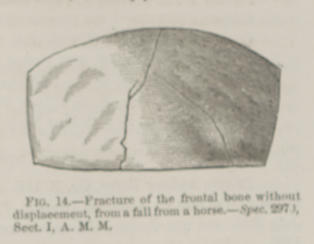Title: N——, Alexander
Source text: Surgeon General Joseph K.Barnes, United States Army, The Medical and Surgical History of the War of the Rebellion. (1861–65.), Part 1, Volume 2 (Washington, D.C.: Government Printing Office, 1870), 42-43.
Civil War Washington ID: med.d1e2896
TEI/XML: med.d1e2896.xml
CASE.—Sergeant Alexander N——, Co. B, 13th New York Cavalry, was thrown from his horse while riding in the streets of Washington, on August 10th, 1865, his head striking violently upon the pavement. He was taken to the hospital at Camp Barry in an insensible condition, and, in a few hours, became delirious. He remained so until his death, which took place on August 14th, 1865. There was no external evidence of depression or fracture of the skull, but simply a severe contusion of the forehead. The autopsy revealed a three-branched linear fracture of the frontal bone. Its direction is indicated in the accompanying wood cut. (Fig. 14.) Externally one line of fracture passes from the centre of the superior border of the bone downward and outward through the right frontal eminence. From the upper third of this fissure a second fissure passes nearly at right angles downward through the left frontal eminence. This last fissure involves the external table only. The inner table is fissured to correspond with the first line of fracture, and there is also a short fissure branching upward. The inner table opposite each frontal eminence is reticulated, and in the centre of the perforated plate on the left side there is a small nodule of bone of the size of a grain of wheat. The specimen, with a memorandum of the case, was forwarded to the Army Medical Museum by Surgeon J. M. Homiston, 3d New York Provisional Cavalry.
